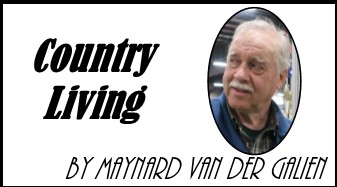I was driving along a country road one morning last week and saw a deer running out of a green alfalfa field towards the road. I slowed down so we wouldn’t meet and collide on the road. When the deer, which looked like a young buck, came closer I stopped to give him the right-of-way to cross the road. At the edge of the ditch he stopped and looked at the red truck I was in. We both looked at each other for a few minutes. Finally I tooted the horn and he ran off along the ditch into a clump of trees and I felt it was safe to drive on.
I am lucky to never have had a collision with a deer. When I see deer along the side of a road or coming out of a field I am on my guard. One time, near home, a deer came bounding out of an alfalfa field and crossed in front of me in graceful leaps. It was too close and frightened me.
Seeing a deer so close up or for that matter even seeing a deer is something we never saw when I was a youngster or a teen. The only time we saw a deer was one or two dead ones strapped to the roof of a vehicle during hunting season. Hunters loved to show off their kill. Deer stayed hidden in the bush and hounds would chase them out to the runways where hunters would be waiting. In the winter we’d see deer tracks in the cedar swamp and saw where they had been feeding and their poop pellets. We never saw a deer grazing in our hay fields.
Every summer now for years I have a doe who gives birth in the same area by one of my creeks that runs through the farm. From the road I’ll see a deer standing in the tall grass by the creek. If I drive the roadway to the field going by the creek, the deer will suddenly disappear from view, but she hasn’t leaped away.
When I had the field in hay I would watch very closely when cutting the first few rounds because I knew there would be a fawn or two hidden in the tall grass. One of the many advantages of cutting hay with a self-propelled swather is that the operator is sitting up high (like in a combine) and looks ahead and down into the forage. The operator can watch for little packed down spots where deer will hide their young while they go feed or quench their thirst at a waterhole. Farmers cutting with a haybine or discbine can’t see little fawns because the operator is sitting lower and hay is cut off on one side behind the tractor. Fawns get killed.
Some years ago I was cutting hay by the creek field and saw a deer lingering at the end of the field. I knew she had fawns hidden nearby and I was coming closer and closer to where she stayed. There was no way I was going to walk through the tall grass looking for the fawns. The deer could take a run at me. With the header of the swather up, I drove slowly towards the deer, which turned her head everywhere but not down to the ground. She was trying to fool me. About 40 feet from the deer I spotted one tiny little fawn struggling through the tangled alfalfa trying to get to its mom. It was incredibly tiny with spindly little legs.
I went home and cut again later that day. The pair had moved out of the field.
Females give birth to one to three (usually two) fawns that are born with a reddish-brown coat covered with white spots that allow them to blend naturally with patterns of sunlight and shade.
At birth, a white-tail deer weighs only 4-6 pounds. The one I saw was probably born that night. Just one!
It’s a wonderful sight observing a tan-coloured deer nursing two fawns. The fawns are so darn cute with their reddish-brown coat of hair covered in white spots. I see beef calves nursing all the time so why do I get sentimental about young wildlife having an early morning snack of warm milk?





![Kenopic/Smith Auction [Paid Ad]](https://whitewaternews.ca/wp-content/uploads/2018/10/advertising-100x75.jpeg)

